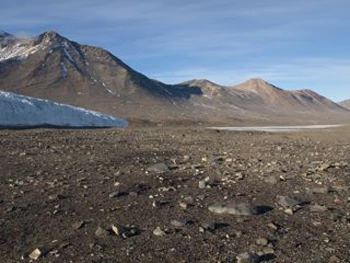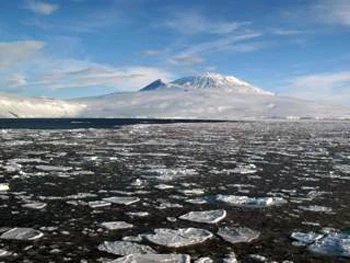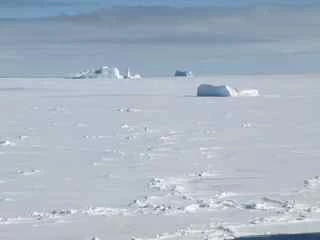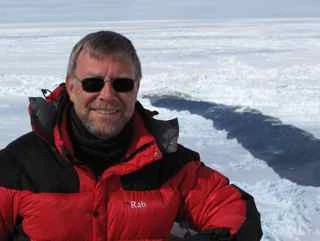Tom Sharpe's Antarctic Diary 2012-01-03
, 3 Ionawr 2012
Tuesday 22 November 2011
Overnight we sailed across McMurdo Sound and pushed into the fast ice along the coast of the mainland. It was a beautiful day today, except where we wanted to be - in the mountains.
There, low cloud meant the helicopters couldn’t fly. So instead we spent the morning walking on the ice around the ship. Our presence attracted the attention of a group of Emperor penguins who were just as interested in us as we were in them. They were definitely there to have their pictures taken! They leapt in and out of the water, waddled back and forth, stood, posed and almost smiled for our cameras.
By early afternoon the weather showed signs of improvement, so we flew across the fast ice and into the Taylor Valley, one of the Dry Valleys. These are remarkable features, the largest ice-free area in the continent. Taylor Valley was discovered by Scott on his first expedition while returning from a sledging trip to explore the Polar Plateau with Edgar Evans from Rhossili on Gower.
The Dry Valleys are a polar desert where the rocks are smoothed and sculpted by sand blown by katabatic winds which hurtle down from the Antarctic ice sheet at speeds of up to 200 mph. They attract a lot of scientific attention, especially from NASA, as this is probably the closest we have to a Martian landscape and climate. It was a real thrill to experience this incredible landscape.
The valley is strewn with moraines with huge variety of rock types. Two geologists from Scott’s last expedition, Frank Debenham and Griffith Taylor, explored this valley and collected from these moraines. This gave them samples of rocks from deeper into the Transantarctic Mountains which they did not have time to explore.
Wednesday 23 November 2011
After a bright sunny night, we awoke to find ourselves back in the fast ice of Ross Island, this time offshore of Cape Evans. Visiting Shackleton’s Hut was wonderful, the Dry Valleys exceptional, but today was very much the icing on the Ross Sea cake, and for most of us, the whole reason for this trip - a visit to Captain Scott’s hut, the hut from which he left for the South Pole and to which he never returned.
Almost buried in snowdrifts, the hut has a powerful presence, seeped as it is in Antarctic history. Stepping through the door was a strange experience. In front of me was a large room that I knew well, but I was seeing it for the first time in colour. I know this hut from the famous photographs of Scott’s expedition photographer, Herbert Ponting.
I was standing where he stood, at the end of the long table, when he took the picture of Scott’s birthday. I stood between the sleeping bags of Teddy Evans and Edward Wilson, from where Ponting photographed Scott sitting at his desk. I saw the empty Tenements, the bunks of Apsley Cherry-Garrard, Birdie Bowers, and Captain Oates, and could visualise them there, as in Ponting’s photograph. Above Oates’ bunk - his pinups: pictures of horses and dogs. Atkinson’s laboratory, his test tubes and equipment still on the bench; the Geologists’ Cubicle, with rocks on the floor beneath Frank Debenham’s bunk; Ponting’s darkroom, still smelling of developer and fixer; the Stables where Oates cared for the ponies, and the stove he used to heat their chaff; Clissold the cook’s galley with its stove, utensils, and canned foodstuffs; and, dividing the hut, a wall of crates of Coleman’s mustard, Fry’s chocolate and other supplies. All of these are still where Ponting photographed them a century ago.
Of course, a feeling of sadness and tragedy pervades this hut; it is almost tangible. Almost exactly 100 years ago, Scott, Oates, Bowers, Wilson and Edgar Evans left this building and set out for the South Pole and a frozen death.
Less well known is that this hut was used by Shackleton’s Ross Sea Party who were laying the depots for his doomed crossing of the continent in 1916. Three of their number lost their lives on the ice near here. A forlorn, poignant pencilled scribble beside a bunk records “Loses to date Hayward, Mack, Smith”. In their memory, their colleagues erected a wooden cross on Wind Vane Hill near the hut.
The setting of the hut was enhanced by some suitable weather today; kind enough at times to allow our helicopters in, but showing how quickly the weather can change here. Snow showers, fine spindrift, a driving wind and windchill of -10oC reminded us what conditions here can be like, even less than a month from midsummer.







